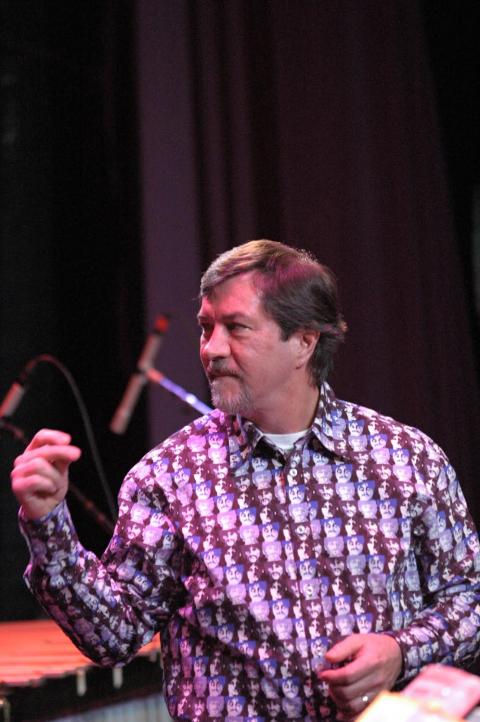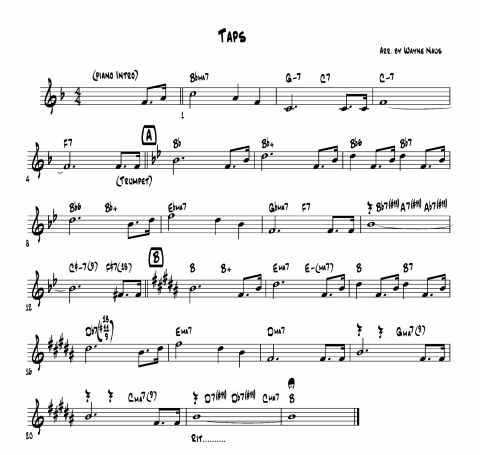Modulation
On one level, the process of modulation is simply a change from one key or tonal center to another. But on another level, it can also trigger a variety of emotional responses from the listener. Depending on the technique or combination of techniques used, modulation can help music to more effectively evoke a mood.
Several factors govern the effects of modulation. But simply put, major keys generally produce a positive or happy effect; minor keys, a sad one. Tempo is also a factor. Depending on whether the move to the new key is harmonically prepared or unprepared, for example, modulations may be smooth or abrupt. In addition to modulations to major and minor keys, it is possible to modulate between various modes and keys and to create some interesting modal-tonal combinations.
Modulation: Objectives and Techniques

Wayne Naus, a professional trumpet player, is a professor in the Harmony Department. He is the author of Beyond Functional Harmony published by Advance Music. For more information, visit www.waynenaus.com.
In this article, I will confine the discussion to actual key changes and explore five techniques for modulating: direct, pivot-chord, melody driven, transitional, and combination modulations. No matter which technique you use to create a modulation, you need to ask three questions: (1) What is the desired effect? (2) What is the destination key? and (3) Which technique will get you there?
Note that you can heighten the effect of a modulation if you change not only key but also tempo. Further, when visual images accompany a modulation, the psychological or emotional effect can be even greater. Each modulation should be tailored to a particular musical situation. In many cases, musicians use a modulation at the chorus or bridge of a tune or as a segue between songs in a medley. Many jazz tunes (especially those in the bebop style) modulate frequently, creating a potential harmonic obstacle course for the player. Regardless of the type of modulation used, it must be a carefully sculptured musical event that involves a series of harmonic and melodic choices that conform to the style and context of the music at hand.
The diagram below shows the harmonic, melodic, and key relationships that are involved in a modulation. When two or more of these elements are combined, it creates what I call a “combination modulation.” Even though the listener hears these relationships over the course of only a few seconds as the key changes, such modulations initiate an emotional response. The listener may not even be consciously aware of the combined relationships in a modulation. But the overall effect may convey a feeling of optimism or new beginning, even the sensation of goose bumps. Audio files examples 8 and 9, “America the Beautiful” and “Taps” are examples of this. (To hear all musical examples, visit http://www.berklee.edu/bt/192/lesson.html.)
Examples of Modulation
Examples 1 through 7 demonstrate various combinations of harmonic, melodic, and key relationships that produce a range of modulation types with varied levels of complexity. Example 1 shows a direct modulation that uses two preparatory chords, Eb-7 and Ab7 (the II-7 and V7 of the new key). They set up the key change.
Example 2 is a pivot-chord modulation. In bar 3, the F-7 is called the pivot chord because it has a dual function as IV-7 in the key of C and as the II-7 in the key of Eb. This type of modulation is more subtle than a direct modulation. Also in bar 3, the melody note C contributes to the effect of this approach on the listener. The ear perceives the C as the root in the key of C and as the sixth degree in Eb. Harmonically, the C functions as the fifth of the F-7 chord and the ninth on the Bb7 chord.
Example 3 shows a combination of pivot-chord and direct modulations that involve a different interaction between the melody, harmony, and adjacent keys, adding a greater degree of complexity. In bar 2, the G7 chord resolves in a deceptive cadence to an Ab maj7; in bar 3, a chord that functions in both keys. In bar 3, the melody note is the root in the key of C and the third degree in Ab.
Example 4 shows an unprepared, direct modulation that is melody driven and accomplished through the use of a common tone. The C in bars 3 and 4 is diatonic to both chords and keys. In the key of C, it’s the root; and in Db, the seventh. On the Ab7 chord, the C functions as the third; and on the Db chord it’s the seventh. The audio file of this example demonstrates the effect the change of melodic function creates.
Example 5 is another combination of pivot-chord and direct modulations that capitalizes on the interaction between the harmony, melody, and adjacent keys. The melody note F in bar 3 is the fifth degree in the home key of Bb and the third in the new key of Db. It’s the root of the F7 chord and the third of the Db chord. Because of the deceptive resolution of the F-7, the Db chord has a function in both keys.
Example 6 shows another combination of direct and pivot-chord modulations. In bar 3, the melody note E is the third degree in the key of C and the fifth in A. The G7 chords have a function in both keys. Because of its deceptive resolution, the A maj7 chord can be heard as functioning in both keys. In the key of C, it is a rare example of a VI maj7 chord. This complex modulation can affect the listener on many levels.
Example 7 is a transitional modulation. During the three-bar transition from the key of C to Db (see bars 3 to 5), the feeling of the key of C is lost, and there is no expectation of what the new key will be. The process begins with a series of II-7 V7s, which don’t resolve and imply the keys of Eb and D. The melody is sequential and moves in an ascending direction, adding to the forward momentum provided by the harmony. Since there is no expectation of a key destination, this type of modulation can continue until the desired key is reached.
As mentioned above, examples 8 and 9 are versions of “America the Beautiful” and “Taps” that I arranged and played on the trumpet to demonstrate modulation techniques. These modulations were designed to produce an emotional response that is impossible to sum up in a description of the techniques utilized.
I hope some of the ideas in this article and the musical examples may inspire you to continue on a path of musical discovery, inspiration, and creativity.

EX.1

EX.2

Ex.3

ex.4

ex.5

Ex.6

ex.7

EX.8

ex.9




